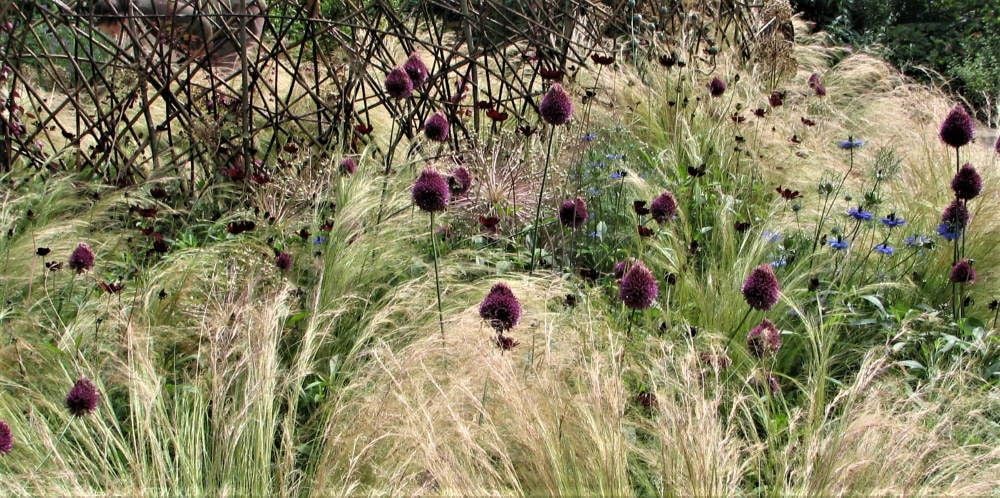
Best plant and Ornamental Grass Combinations
Let's start with this lovely planting combination captured above. I took this at RHS Harlow Car, and it shows Stipa tenuissima, a grass with wispy flower heads, combined with late flowering purple Allium sphaerocephalon, blue cornflowers, and the seed heads of Allium cristophii to create a fine late summer display.
If you are looking for inspiration to see displays of grasses in a garden setting, the RHS latest flagship garden in Manchester Bridgewater has fantastic planting arrangements using various grasses shown on Pinterest.
More about How and Where to Grow Ornamental Grasses
Below are some easy-to-grow combinations of perennials and decorative grasses.
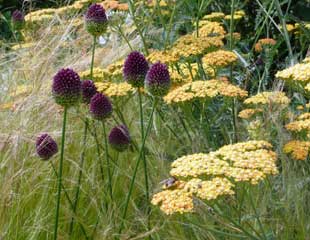
Stipa tenuissima, Allium and Achillea, a mid to late summer combination
Key points:
Stipa tenuissima fluffy and wispy
Terracotta Achillea, flat headed flowers
Allium sphaerocephalon, which is a late flowering variety.
This is a great combination, which is at its best in July and August.
For this combination to work, the choice of Allium is important because many Alliums are spring flowering in May, and for this it is essential to plant the late summer flowering A. spaerocephalon, which will flower in July and August. Plant this combination in a sunny spot with well-drained soil, and it should return each year reliably.
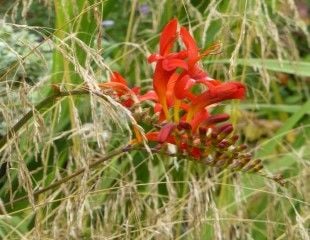
Midsummer flowering Crocosmia and grasses.
Key Points
Tall grass such as Stipa gigantea, or Stipa ichu, with arching habit
Tall Scarlet Crocosmia 'Lucifer'
Crocosmia looks good with certain grasses as they reflect and share with an the arching habit. The smaller yellow and orange varieties of Crocosmia also work well with grasses such as Deschampsia cespitosa and Molinia caerulea, purple moor grass, which look good together. Both Crocosmia and the grasses are easy to grow, simply plant in a sunny spot, although the taller Crocosmia may require staking.
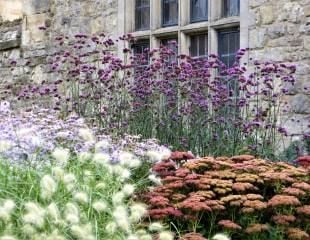
Late flowering Verbena, Sedum, and Pennisetum, ideal for a sheltered sunny spot
Key points
Tall purple verbena
autumn-flowering Sedum
Pale Penstemon
Add in/substitute the penstemon, Stipa tennuissima or Deschampsia for a fully hardy planting arrangement.
This combination needs a sheltered spot because this variety of Pennisetum is not fully hardy, only H3, which is coastal gardens and milder areas. It combines well here with the reliable perennials Verbena, tall purple spires and the dark Autumnal shades of Sedum. This was spotted growing in a walled area of a garden in an Oxford college. A hardier substitute for the Pennisetum would be Stipa tennuissima or Deschampsia to create a fully hardy combination.
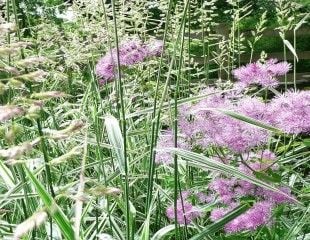
Thalictrum and Phalaris -ideal combination for damp and shade
Key Points
This is a combination suitable for damp and shade.
Thalictrum aquilegiifolium (Meadow rue) and Phalaris arundinacea (Gardeners garter)
Easy to grow, can be vigorous.
Most grasses like a sunny spot, but this is a combination for damp ground and partial shade. Thalictrum is easy to grow shown here is a shade of soft mauve combined with Phalaris arundinacea, which has leaves with a mauve tinge that tones well with the Thalictrum. Both plants are fully hardy perennials, which can be vigorous, suitable for large spaces and ideal ground cover where needed.
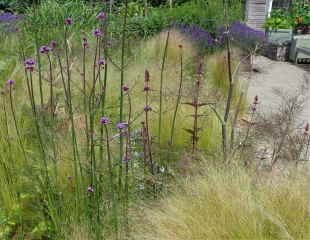
Stipa and verbena a combination for dry areas
Key Points
Golden bronze Stipa tenuissima planted with tall purple verbena bonariensis
Easy to grow, drought-tolerant combination.
Note there are different varieties of Verbena that vary in height, and some are annuals, illustrated is V.bonariensis.
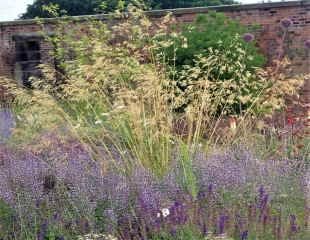
Stipa Gigantea, with calamintha sylvatica, agastache
Key Points
Stipa Gigantea tall golden oat coloured grasses, combined with the soft blue of Calamintha (Cat Mint) sylvatica,and purple agastache.
Another bronze/purple combination, popular with pollinators and bees. All are frost-hardy and perennial.
Will grow in a sunny spot with reasonably well-drained soil.
This is another image of a great planting combination at RHS Bridgewater, well worth a visit for so much inspired planting, including grasses.
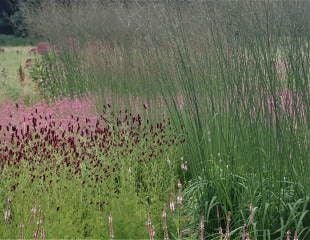
Molinia grass with Sanguisorba and purple loosestrife
Key Points
Molinia grass with Sanguisorba, common name burnett and purple loosestrife, a native wildflower loved by butterflies.
This combination will grow in sun or semi shade and in moist soil.
Great combination for a semi wild setting and all are easy to grow. The Burnett will attract bees, and the loosestrife both bees and butterflies.
Towering over the planting is shimmering Molinia grass to make a lovely Great Burnet and purple loosestrife

Teasel
Key points
Not a grass, but an architecturally attractive, tall biennial wildflower
Grows to around 2-3M, in any soil its very robust
Self-seeds and are loved by pollinators when flowering, and birds eat the seeds.
It would look good planted with wildflowers such as purple loosestrife, mallow, yarrow and wild carrot.
It is a self-seeding biennial which grows up to around a meter plus with very attractive seed heads. Not only do we like them, but bees find them a wonderful source of nectar during the summer flowering months, insects live in them, and goldfinches love the seed heads. Teasels make great structural plants, especially in a wildlife area, combined with natural grasses.
